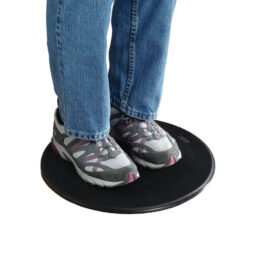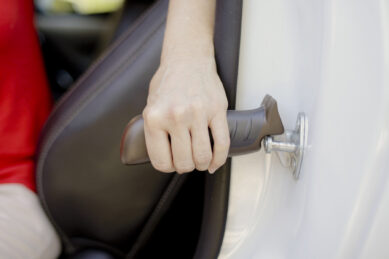
Simpler, Safer Transfers: Helpful Tips and Useful Equipment
By Maggie Callahan | Wednesday, July 2, 2025

Theresa Berner is an occupational therapist.
Transferring from one spot to another, such as from a bed to a wheelchair and from a wheelchair to a toilet, can be a daily challenge for those living with neuromuscular diseases. Whether at home or out and about, being able to transfer easily, safely, and comfortably is a high priority for people with limited mobility and their caregivers.
Occupational therapists (OTs) are trained to help people complete daily tasks, and transfers are an important part of daily living.
“When I begin working with someone, I ask them to consider what daily activities are difficult for them to do, and we look for ways to make it easier or find modifications,” says Theresa Berner, MOT, OTR/L, ATP, an OT and Rehabilitation Clinical Manager at The Ohio State University Wexner Medical Center.
Theresa works with many patients living with amyotrophic lateral sclerosis (ALS) and is familiar with many modifications and pieces of equipment that can make transfers easier, safer, and more comfortable. Here, she shares her top recommendations.
Useful equipment
Transfer boards
These portable boards help a person using a wheelchair move to and from a bed, toilet, or car. Transfer boards come in various sizes and materials. Plastic boards are usually lighter than wooden options. Some styles, such as BeasyBoards, have a movable disc that glides with the person being moved.

Pivot disc
Pivot discs
These go under a person’s feet, for those who can’t bear much weight or stand up all the way. This allows the caregiver to pivot the person so they can sit or lie on the new surface.
Slings
There are many types of slings. Some connect to a floor lift that is on wheels (often called a Hoyer lift), allowing the caregiver to push it from room to room. A ceiling lift also helps a caregiver move someone sitting in a sling from room to room, but it attaches via tracks in the ceiling. These are ideal for people who can’t bear weight. Portable lifts are available for traveling.
Sit-and-stand slings are helpful for those who can bear some weight, and they reduce strain for caregivers, helping to protect against injuries.
“These sit-and-stand portable options are helpful anywhere,” Theresa says. One portable sling example is the AbleSling Lite.
Slings typically have multiple loops, allowing the person to be held more tightly or more loosely as needed. Theresa suggests color coding the links or loops for easier communication. “A person could say, I’d like to be held tighter, so please use the blue loop,” Theresa explains.

Gait belt
Gait belts
For people with some weight-bearing ability, a gait belt offers protection and assistance for them and their caregiver. The person transferring wears the best around their waist, and the caregiver can hold onto it as they assist. Some belts have several loops for a caregiver to hold onto.
Car handle assists
Because many cars are low to the ground, it can be difficult to gain the necessary leverage to transfer to a wheelchair or walker. A portable car handle assist hooks onto the car’s door frame, offering a stable handle for a person to grab as they rise out of the car.

Car handle assist
Lift aids
Other aids, such as the Sara Stedy sit-to-stand aid, can be very helpful for transfers, especially getting to the toilet. A Sara Stedy has a central support bar for the user to grasp, pivoting seat flaps, knee supports, and locking wheels, so semi-weight-bearing individuals can safely stand and transfer with their caregiver. Doctors’ offices and clinics that work with neuromuscular diseases may have sit-to-stand aids. Inquire before your appointment.
Tips for easier transfers
Plan ahead
Consider where you are going, what equipment you will need, and what equipment the location may have available. “Do your homework and reach out for this information if you are not sure,” Theresa says.
For example, if you are going to a doctor’s appointment, she suggests asking questions such as:
- “I need help with transfers. What equipment do you have available?”
- “Will I need to get out of my wheelchair/scooter?”
- “Do you have somebody who can help me?”
For a visit to a barber or hair salon, you may ask:
- “Will I be able to stay in my wheelchair/scooter, or will I have to transfer to a barber chair?”
- “If I have to move to your chair, does it have an arm that can be raised out of the way or removed?”
She adds that staying in a hotel is another notoriously unpredictable experience. Helpful questions to ask before your visit include:
- “Do you have a roll-in shower?”
- “What is the height of your toilet?”
- “What is the width of the bathroom doorway?”
- “What is the height of your bed?”
Asking these questions will help you prepare for less-than-ideal transfer circumstances.
Lift safely
This applies to both the person being lifted and the person doing the lifting.
“Understand the proper body mechanics, so no one gets hurt,” Theresa says. She suggests working with a physical therapist (PT) to learn safe lifting techniques for caregivers.
Speak up
Don’t be afraid to ask for the specific help or assistance you need. When you’re being lifted, be sure to communicate with the person assisting you.
“It’s OK to guide the person helping you and let them know what works or feels best,” Theresa says. “To make it easier, you can have a pre-rehearsed speech, such as, ‘Thank you for trying to help me. I would prefer you put your hand here instead.’”
Lastly, Theresa urges people with neuromuscular diseases to be aware of when they need extra help with transitions. “Neuromuscular diseases can progress slowly, so it’s important to know what your options are for safe transfers as your needs change.”
With the right tools, patience, and planning, transfers can be safe and comfortable.
Next Steps and Useful Resources
- Learn how to choose the right lift device or lift system for your needs.
- Make travel easier by packing the right mobility equipment and adaptive travel gear.
- For more tips, read Easy, Expert-Level Life Hacks from an Occupational Therapist.
- Stay up to date on Quest content! Subscribe to Quest Magazine and Newsletter.
TAGS: Caregiving, Equipment and Assistive Devices, Featured Content, Personal Care Attendants, Travel
TYPE: Blog Post
Disclaimer: No content on this site should ever be used as a substitute for direct medical advice from your doctor or other qualified clinician.




